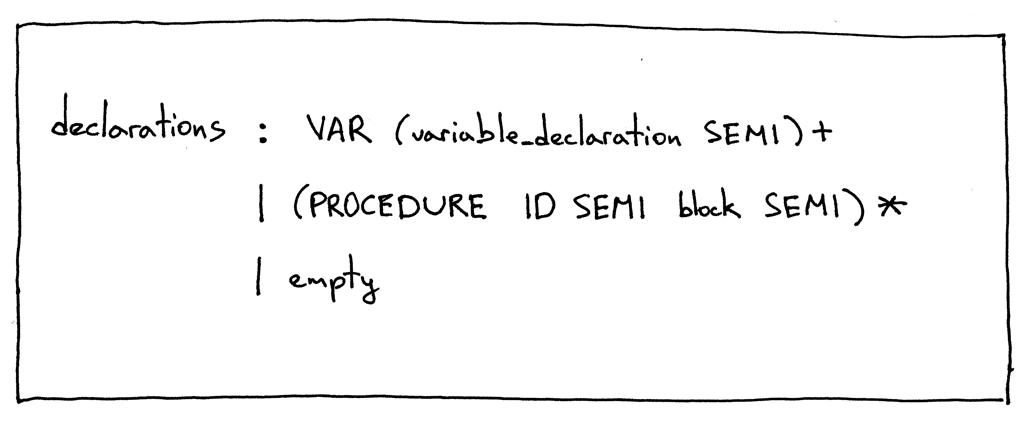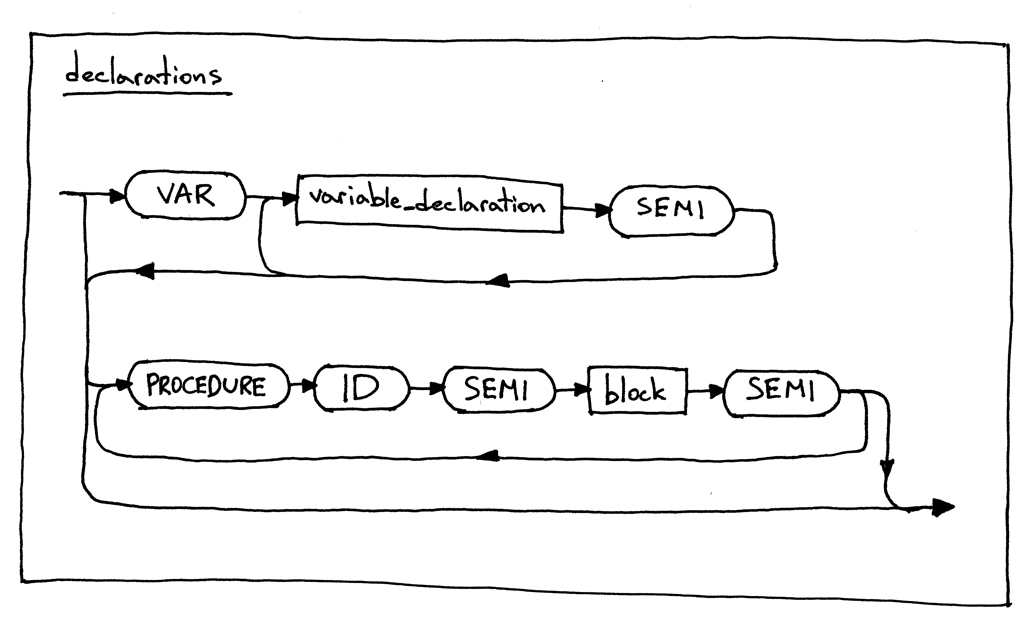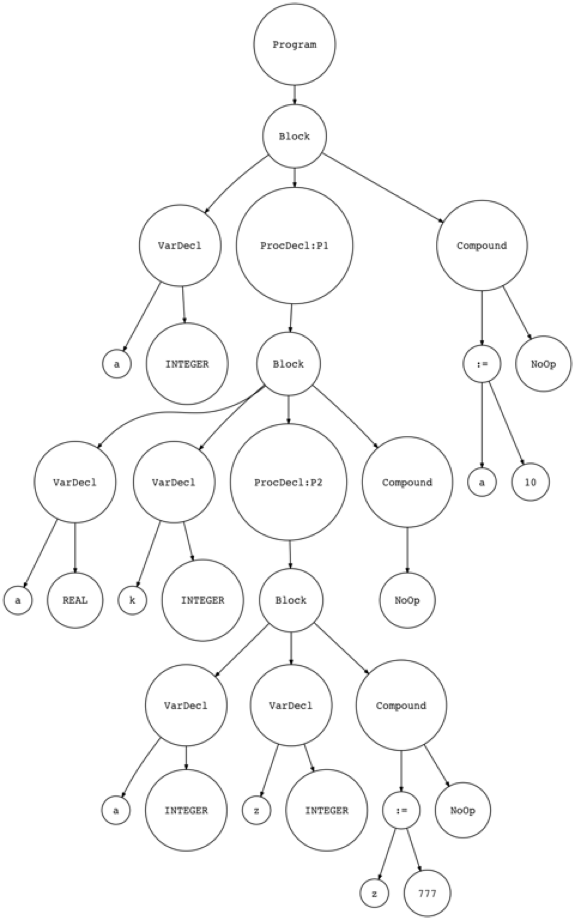“Be not afraid of going slowly; be afraid only of standing still.” - Chinese proverb.
Hello, and welcome back!
Today we are going to take a few more baby steps and learn how to parse Pascal procedure declarations.

What is a procedure declaration? A procedure declaration is a language construct that defines an identifier (a procedure name) and associates it with a block of Pascal code.
Before we dive in, a few words about Pascal procedures and their declarations:
- Pascal procedures don’t have return statements. They exit when they reach the end of their corresponding block.
- Pascal procedures can be nested within each other.
- For simplicity reasons, procedure declarations in this article won’t have any formal parameters. But, don’t worry, we’ll cover that later in the series.
This is our test program for today:
PROGRAM Part12;
VAR
a : INTEGER;
PROCEDURE P1;
VAR
a : REAL;
k : INTEGER;
PROCEDURE P2;
VAR
a, z : INTEGER;
BEGIN {P2}
z := 777;
END; {P2}
BEGIN {P1}
END; {P1}
BEGIN {Part12}
a := 10;
END. {Part12}
As you can see above, we have defined two procedures (P1 and P2) and P2 is nested within P1. In the code above, I used comments with a procedure’s name to clearly indicate where the body of every procedure begins and where it ends.
Our objective for today is pretty clear: learn how to parse a code like that.
First, we need to make some changes to our grammar to add procedure declarations. Well, let’s just do that!
Here is the updated declarations grammar rule:

The procedure declaration sub-rule consists of the reserved keyword PROCEDURE followed by an identifier (a procedure name), followed by a semicolon, which in turn is followed by a block rule, which is terminated by a semicolon. Whoa! This is a case where I think the picture is actually worth however many words I just put in the previous sentence! :)
Here is the updated syntax diagram for the declarations rule:

From the grammar and the diagram above you can see that you can have as many procedure declarations on the same level as you want. For example, in the code snippet below we define two procedure declarations, P1 and P1A, on the same level:
PROGRAM Test;
VAR
a : INTEGER;
PROCEDURE P1;
BEGIN {P1}
END; {P1}
PROCEDURE P1A;
BEGIN {P1A}
END; {P1A}
BEGIN {Test}
a := 10;
END. {Test}
The diagram and the grammar rule above also indicate that procedure declarations can be nested because the procedure declaration sub-rule references the block rule which contains the declarations rule, which in turn contains the procedure declaration sub-rule. As a reminder, here is the syntax diagram and the grammar for the block rule from Part10:

Okay, now let’s focus on the interpreter components that need to be updated to support procedure declarations:
Updating the Lexer
All we need to do is add a new token named PROCEDURE:
PROCEDURE = 'PROCEDURE'
And add ‘PROCEDURE’ to the reserved keywords. Here is the complete mapping of reserved keywords to tokens:
RESERVED_KEYWORDS = {
'PROGRAM': Token('PROGRAM', 'PROGRAM'),
'VAR': Token('VAR', 'VAR'),
'DIV': Token('INTEGER_DIV', 'DIV'),
'INTEGER': Token('INTEGER', 'INTEGER'),
'REAL': Token('REAL', 'REAL'),
'BEGIN': Token('BEGIN', 'BEGIN'),
'END': Token('END', 'END'),
'PROCEDURE': Token('PROCEDURE', 'PROCEDURE'),
}
Updating the Parser
Here is a summary of the parser changes:
- New ProcedureDecl AST node
- Update to the parser’s declarations method to support procedure declarations
Let’s go over the changes.
-
The ProcedureDecl AST node represents a procedure declaration. The class constructor takes as parameters the name of the procedure and the AST node of the block of code that the procedure’s name refers to.
class ProcedureDecl(AST): def __init__(self, proc_name, block_node): self.proc_name = proc_name self.block_node = block_node
-
Here is the updated declarations method of the Parser class
def declarations(self): """declarations : VAR (variable_declaration SEMI)+ | (PROCEDURE ID SEMI block SEMI)* | empty """ declarations = [] if self.current_token.type == VAR: self.eat(VAR) while self.current_token.type == ID: var_decl = self.variable_declaration() declarations.extend(var_decl) self.eat(SEMI) while self.current_token.type == PROCEDURE: self.eat(PROCEDURE) proc_name = self.current_token.value self.eat(ID) self.eat(SEMI) block_node = self.block() proc_decl = ProcedureDecl(proc_name, block_node) declarations.append(proc_decl) self.eat(SEMI) return declarations
Hopefully, the code above is pretty self-explanatory. It follows the grammar/syntax diagram for procedure declarations that you’ve seen earlier in the article.
Updating the SymbolTable builder
Because we’re not ready yet to handle nested procedure scopes, we’ll simply add an empty visit_ProcedureDecl method to the SymbolTreeBuilder AST visitor class. We’ll fill it out in the next article.
def visit_ProcedureDecl(self, node):
pass
Updating the Interpreter
We also need to add an empty visit_ProcedureDecl method to the Interpreter class, which will cause our interpreter to silently ignore all our procedure declarations.
So far, so good.
Now that we’ve made all the necessary changes, let’s see what the Abstract Syntax Tree looks like with the new ProcedureDecl nodes.
Here is our Pascal program again (you can download it directly from GitHub):
PROGRAM Part12;
VAR
a : INTEGER;
PROCEDURE P1;
VAR
a : REAL;
k : INTEGER;
PROCEDURE P2;
VAR
a, z : INTEGER;
BEGIN {P2}
z := 777;
END; {P2}
BEGIN {P1}
END; {P1}
BEGIN {Part12}
a := 10;
END. {Part12}
Let’s generate an AST and visualize it with the genastdot.py utility:
$ python genastdot.py part12.pas > ast.dot && dot -Tpng -o ast.png ast.dot

In the picture above you can see two ProcedureDecl nodes: ProcDecl:P1 and ProcDecl:P2 that correspond to procedures P1 and P2. Mission accomplished. :)
As a last item for today, let’s quickly check that our updated interpreter works as before when a Pascal program has procedure declarations in it. Download the interpreter and the test program if you haven’t done so yet, and run it on the command line. Your output should look similar to this:
$ python spi.py part12.pas
Define: INTEGER
Define: REAL
Lookup: INTEGER
Define: <a:INTEGER>
Lookup: a
Symbol Table contents:
Symbols: [INTEGER, REAL, <a:INTEGER>]
Run-time GLOBAL_MEMORY contents:
a = 10
Okay, with all that knowledge and experience under our belt, we’re ready to tackle the topic of nested scopes that we need to understand in order to be able to analyze nested procedures and prepare ourselves to handle procedure and function calls. And that’s exactly what we are going to do in the next article: dive deep into nested scopes. So don’t forget to bring your swimming gear next time! Stay tuned and see you soon!
If you want to get my newest articles in your inbox, then enter your email address below and click "Get Updates!"
All articles in this series:
- Let's Build A Simple Interpreter. Part 1.
- Let's Build A Simple Interpreter. Part 2.
- Let's Build A Simple Interpreter. Part 3.
- Let's Build A Simple Interpreter. Part 4.
- Let's Build A Simple Interpreter. Part 5.
- Let's Build A Simple Interpreter. Part 6.
- Let's Build A Simple Interpreter. Part 7: Abstract Syntax Trees
- Let's Build A Simple Interpreter. Part 8.
- Let's Build A Simple Interpreter. Part 9.
- Let's Build A Simple Interpreter. Part 10.
- Let's Build A Simple Interpreter. Part 11.
- Let's Build A Simple Interpreter. Part 12.
- Let's Build A Simple Interpreter. Part 13: Semantic Analysis
- Let's Build A Simple Interpreter. Part 14: Nested Scopes and a Source-to-Source Compiler
- Let's Build A Simple Interpreter. Part 15.
- Let's Build A Simple Interpreter. Part 16: Recognizing Procedure Calls
- Let's Build A Simple Interpreter. Part 17: Call Stack and Activation Records
- Let's Build A Simple Interpreter. Part 18: Executing Procedure Calls
- Let's Build A Simple Interpreter. Part 19: Nested Procedure Calls
Comments
comments powered by Disqus